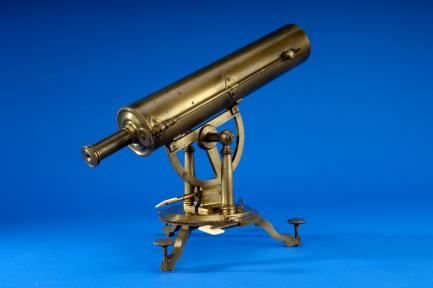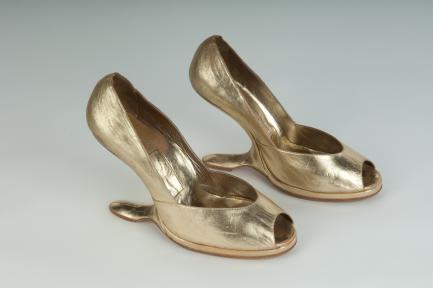“American Stories” Exhibition Opens at National Museum of American History
The Smithsonian’s National Museum of American History will open a signature exhibition, “American Stories,” April 12 that takes visitors on a journey through time by telling both well- and little-known stories about the American experience.
“American Stories” presents a chronology of American history from European and Native cultural encounters of the early 1600s through the 2008 Presidential election. It tells stories through more than 100 objects, including Dorothy’s Ruby Slippers, a rarely displayed walking stick used by Benjamin Franklin, Abraham Lincoln’s gold pocket watch and Muhammad Ali’s boxing gloves.
The exhibition is designed to serve as an introductory experience to American history and as a dedicated space to feature new acquisitions that illustrate the breadth of the American experience. Recent acquisitions on view include a Revolution-era sampler made by a 13-year-old girl, a creeping (crawling) baby doll (1870s) and a typewriter used by poet Lawrence Ferlinghetti (about 1960).
“This exhibition tells us many of the stories we share as individuals, communities and as a nation,” said Marc Pachter, interim director of the museum. “Objects are witnesses to the past that lead you to stories that shape our American experience. This visually vibrant exhibition aims to delight as well as inform.”
All of the objects are from the museum’s vast collections except for two loans. Franklin’s three-piece plain-silk suit, worn at the Treaty of Alliance signing in 1778, will be on display only through May 7 and belongs to the Massachusetts Historical Association. The leather jacket Bob Dylan wore during his epic 1965 performance at the Newport Folk Festival is on loan from an anonymous collector.
This is the first general subject exhibition for which the museum has translated all the labels into Spanish. “American Stories” also features a bilingual website. The Spanish guide is available by request at the museum information desks, accessible via smart phone through a QR code at the exhibition entrance and online as a PDF at americanhistory.si.edu/historiasamericanas.
“‘American Stories’ highlights the ways in which objects and stories can reinforce and challenge our understanding of American history and help define our personal and national identities,” said Bill Yeingst, project director and chair of the Home and Community Life division. Exhibition Curator Bonnie Campbell Lilienfeld added that the exhibition examines the manner in which culture, politics, economics, science and technology have shaped life in the U.S. and how the peopling of America has contributed to the rich distinctiveness of a country influenced by diverse cultural communities.
The exhibition examines this premise in five main sections, and each cluster is modeled on the historical eras defined in the National Standards for History:
- Forming a New Nation focuses on the period from 1776 to 1801 exploring how America’s diverse populations—Native peoples, Europeans and Africans—interacted to create a hybrid new world. Objects in this first section help tell stories about the formation of the U.S., from the Colonial period to the Revolutionary War and its immediate aftermath. Objects include a silver milk pot from 1774 and Joseph Ellicott’s tall case clock completed in 1769.
- Expansion and Reform looks at ways in which westward migration, technological advances and rapid economic development pushed the country onward even as they threatened to break it apart (1801 to 1870). Urbanization and industrialization led to new social challenges while slavery and sectional politics drove the country to civil war. The objects in this section convey stories about the War of 1812, the growth of the nation, innovation and the Civil War, including an 1833 slave ship manifest and a sunstone capital from the temple of the Church of Jesus Christ of Latter-day Saints at Nauvoo, Ill.
- Industrial Development highlights the period following the Civil War, during 1870 to 1900, when the U.S. rapidly transformed into an industrial and urbanized nation. This group of objects highlights industrialization and innovation in the late 1800s and the benefits, as well as the detriments, of becoming an economic and industrial power. Objects include Alexander Graham Bell’s box telephone and an 1873 typewriter made by E. Remington and Sons.
- Emergence of Modern America explores the U.S. from 1900 to 1945 as it proved itself as a military, technological and economic giant on the world stage while it faced economic and social disparity on the home front. The objects in this section illustrate some of the major themes of the first half of the 20th century: world war, innovation, financial instability and the emergence of modern popular culture. Objects include a Navajo blanket with an American flag made for a WWI soldier and a purse carried by Camilla Gottlieb, an Austrian Jew who survived a concentration camp and immigrated to the U.S.
- Postwar and Contemporary America spans from 1945 to the present and explores the shadows cast by “cold” and “hot” wars across post-World War II prosperity and the ways that social, cultural and technological revolutions changed how and where people live. Scientific and medical breakthroughs, technological innovation, political and social change and popular culture characterize the objects in the final section, including Jonas Salk’s polio vaccine and the Kermit the Frog puppet.
In conjunction with the exhibition, the Smithsonian is releasing, for the first time, an app that uses mobile technology and crowdsourcing to make the exhibit experience more accessible to visitors with disabilities. The first phase of the Access American Stories app contains recordings by staff and museum visitors that describe all the objects in the show. Questions prompt contributors to describe objects in effective and engaging ways within a brief recording time. A second phase will include video recording allowing deaf visitors to use sign language to interpret, respond to and comment on the objects. Available in English and Spanish and on Android and iPhone platforms, the app can be downloaded at www.si.edu/apps/accessamericanstories.
The companion website americanhistory.si.edu/stories features the objects and stories from the exhibition. The museum also is inviting visitors, in person and online, to suggest objects for future collection that would reflect their history and place in America. Suggestions may be submitted online at americanhistory.si.edu/nominateanobject or at a “posting” station within the exhibit.
“American Stories” is made possible by lead individual donor Kenneth E. Behring and lead corporate sponsor kate spade new york. Additional support was provided by Peter and Rhondda Grant, History Channel, Larry and Shelly Brown and the Smithsonian Women’s Committee.
The museum is opening this gallery in anticipation of the upcoming renovation to its West Exhibition Wing. The renovation will cover 120,000 square feet with new galleries on the themes of American business, democracy and culture; an education center focused on objects and hands-on experiences; new spaces for the Lemelson Center for the Study of Invention and Innovation, including its hands-on invention space, Spark!Lab; public plazas for programs; the addition of a first-floor window wall with views to the Washington Monument; and a Hall of Music for live performances. The closing of exhibitions in the West Exhibition Wing is being phased and construction should start in fall 2012.
The National Museum of American History collects, preserves and displays American heritage in the areas of social, political, cultural, scientific and military history. To learn more about the museum, visit http://americanhistory.si.edu. For Smithsonian information, the public may call (202) 633-1000, (202) 633-5285 (TTY).
# # #
SI-166-2012
Laura Duff
202-633-3129
Melinda Machado
202-633-3129











